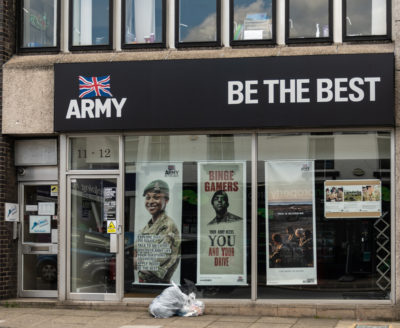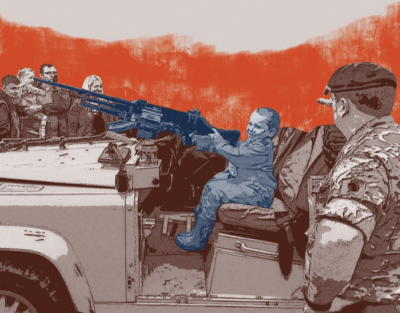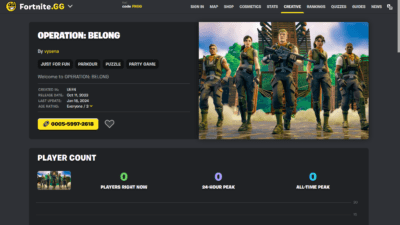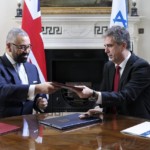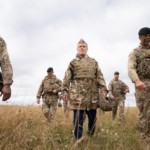Who goes there? Campaigners fight to keep military away from UK schools
The Guardian
Britain is the only EU country to enlist 16-year-olds into the armed services and, say objectors, it starts with access to the classroom.
Britain is the only EU country to enlist 16-year-olds into the armed services and, say objectors, it starts with access to the classroom.
It’s just after 9.30am and a group of year 9 pupils are flinging themselves across a 30m inflatable assault course installed on a playing field at Marlborough science academy in St Albans, Hertfordshire.
“Come on, push through, be positive!” shout the army personnel in charge, as pupils leap on to the military version of a bouncy castle. They are being timed: at 17 seconds from start to finish, Lorna Norris, 14, is the fastest girl. She looks pleased as she and the rest of the group head over to the next set of “command tasks”, aimed at testing their leadership, teamwork and planning skills.
Marlborough science academy is one of thousands of UK schools to invite in the military. Today, as part of an Insight Into Industry event, the army and other organisations – including the fire and rescue service, Marks & Spencer, and Hertfordshire University – are giving students an insider’s view of their work. Next to the assault course is a display showing salary scales for all military ranks, and male and female soldiers from different units are on hand to answer questions.
A group of boys gather round Signaller Chadwick and Guardsman Rowe. “Are you all frontline?” asks Luke Davies-Collins, 14. “What’s it actually like?”
There are rueful grins from the soldiers. “It’s not like it’s the Somme out there,” replies Rowe. “There’s no such thing as a frontline – the threat is all around you.”
The soldiers outline a few of the training options, and explain that there’s a humanitarian aspect to the job, as well as the forces providing support at home in emergencies such as recent floods. If you want to get ahead in the military, it helps to do your best in your exams while you’re at school, Chadwick says.
Later, after a bridge-building group exercise, Lillie Murphy, 14, says the activities have been exciting. Classmate Libby Douglas-Tomsett says her eyes have been opened to the career possibilities: “I didn’t know they had all those different jobs. I thought it was just going to war.”
But “going to war” is often part of a military career – and that prompts controversy about whether schools are being used as recruiting grounds. Applications are accepted age 15 and a half, and military training can start at 16, either at Harrogate Army Foundation college, or Welbeck Defence sixth-form college.
The UK is the only EU country to permit 16-year-olds to enlist and start military training. According to Child Soldiers International (CSI), only 17 other countries allow it, including Zambia, El Salvador and Iran. In June, the UN committee on the rights of the child told the UK government to “reconsider its active policy of recruitment of children into the armed forces and ensure that recruitment practices do not actively target persons under the age of 18 and ensure that military recruiters’ access to schools be strictly limited”.
And an open letter sent in May to the then armed forces minister, Penny Mordaunt, signed by children’s and human rights organisations, teaching unions and the Welsh, Scottish and Northern Irish children’s commissioners (though not the children’s commissioner for England) pointed out that three-quarters of the British public would like to see all-adult armed forces. Most states worldwide, the letter states, enlist into the armed forces only from the age of 18.
The military says it goes into schools only when invited, its sessions are agreed in advance and its activities in the classroom are not about recruitment. “It’s about engaging with society and society better understanding us. It’s about us having a relationship with the society we represent,” says Colonel Simon Stockley, whose role as head of army recruitment encompasses schools and community outreach.
“There’s been so much in the media over the past years in terms of what the army does in places like Afghanistan, and yet our job is also to show that the army’s role goes much further. There is so much more to service than just combat.”
At ForcesWatch, which monitors the military’s presence in schools, coordinator Emma Sangster is sceptical. “Recruitment is a process, it’s not a single event,” she says. Over time, these visits market a lifestyle of opportunity and thrills, and “drip feed things of interest to children of school age”.
This seems to be backed up by the military’s own materials. A 2011 report, in a section titled Overview of Current Defence Youth Activity, states that “servicemen and women engage young people in schools through presentations, discussions, problem solving and personal development activity … This engagement is primarily focused on recruitment, and each service also runs short military familiarisation courses to introduce selected young people to service life.”
In a table in the same document, “development activity in schools” is directly linked to recruitment outcomes. “This ‘taster’ activity is a more sensitive way of introducing service life and encouraging a predisposition to serve,” it says.
ForcesWatch has particular concerns regarding the careers materials and video presentations shown to pupils. “They sanitise what conflict involves, and also glamorise it. They focus on adventure, which young people are desperate for,” says Sangster.
A new video presentation, not shown to the Marlborough pupils on the day I visit, but which I watch in the library later, confirms her point. The overwhelming impression is of a fast-paced, thrilling lifestyle filled with skiing, skydiving, kayaking, rock-climbing and scuba diving, and it shows groups of off-duty soldiers socialising on a posting to Cyprus. Interspersed with the action-packed footage of young people having a blast is a whiz through different roles in the army, an occasional glimpse of tanks racing over rugged terrain and the odd gun barrel shooting a round into a clear blue sky. It looks like an advert for the best adventure holiday ever, with an added frisson provided by the hardware.
And, says Rachel Taylor, programme manager at CSI, the risks children bear in the forces may be greater than if they were to enlist later. A study by CSI and ForcesWatch showed that those who joined at 16 were twice as likely to be killed in Afghanistan as those who joined at 18 or older – despite not being deployed until age 18.
This is because they’re channelled into the most dangerous roles when they’re recruited,” says Taylor. “So, although the Ministry of Defence always says ‘it’s not dangerous to join at 16 because you aren’t deployed until you’re 18’, our response is ‘it’s your age when you enlist that determines the degree of risk you face over your whole career’.”
Annie Thomson, headteacher at Marlborough science academy, has never felt that the military’s sessions at her school pushed a recruitment message. They are invited in, along with representatives from other sectors, she says, “to open up students to the idea that there is a whole range of ways to go forward”.
Issues relating to conflict are examined in a cross-curricular philosophy and ethics programme, she says. There is a cadet force at the school, and Thomson is keen for children to explore their prospects beyond a narrowly academic framework.
“If we had a group of students who were interested in pursuing a route with the army, we’d support them through that process,” she says. There have been, she says, “quite a few” already.
Young people in the armed forces can benefit from career training opportunities they might be pressed to find elsewhere, Stockley says. They are “often young people who, for whatever reason, have not succeeded in traditional education, and [by joining up] they have transformed their lives”, he says.
But there is an ethical question here, says Sangster, if the military is targeting schools in poorer areas, where children may have less good educational outcomes. “Is it acceptable that students from those areas, who’ve not been served well by the education system, should be targeted for a uniquely risky career?” she asks. There is also a military exemption on minimum standards for training, she notes, which means that children who join up at 16 spend two years in college without any guarantees on the quality of their academic or vocational learning experience.
There are moves to examine more carefully the messages given out by the military in educational settings. The Welsh government recently agreed to recommendations for more scrutiny and guidance of armed forces visits to schools, and the Scottish government is considering similar proposals. The Educational Institute for Scotland, the largest teaching union in Scotland, opposes unfettered access to schools by the military for recruitment purposes and the National Union of Teachers in England and Wales is opposed to military recruitment activities in schools that use “misleading propaganda”.
The military has enjoyed high visibility in schools in recent years, with millions of pounds spent on expanding the cadets, the Troops to Teachers initiative, and a teaching resource [pdf] about the military promoted by the Department for Education that sparked criticism from the Quakers, among others.
Back at Marlborough science academy, there’s no doubting that pupils have enjoyed their session with the army. “It’s a lot about leadership, and yes, it’s something I’d want to do when I’m older,” says Ky Hussain, 14. Standing beside him, Libby says what struck her most is the community and friendship that life in the army fosters. “I liked that,” she says.
“I would go for it,” says Lillie, “but at the same time, I’d have to think about it because I’d be scared.”
See more: cadets, legislation & policy, military in schools/colleges, recruitment, recruitment age, Child Soldiers International, ForcesWatch, Quakers, United Nations, education

